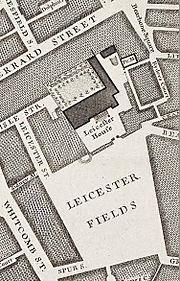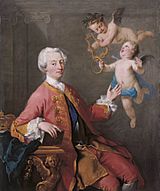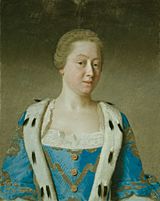Leicester House, Westminster facts for kids
Leicester House was a large, fancy home in Westminster, London. It was built a long time ago, in 1635, by the Earl of Leicester. It was located north of where Leicester Square is today. Many important people lived there, including a princess named Elizabeth Stuart and later, the Hanoverian Prince and Princess of Wales. For a while, it even held a famous museum called the Leverian collection. The house was sold and taken down in 1791.
Contents
Building a Grand Home
Leicester House got its name from Robert Sidney, 2nd Earl of Leicester. He bought a large piece of land in Westminster to build his new home. Back then, this area was mostly open fields.
In 1631, King Charles I gave permission for the Earl to build the house. The King said the house had to be made of brick or stone. He also wanted the front of the house to look beautiful and uniform.
The house was finished around 1635. The Earl of Leicester said it cost about £8,000 to build. This was a huge amount of money back then!
Leicester Fields and Early Visitors
When the Earl built his house, he used some land that was considered "common land." This meant local people could use it. They complained to the King. So, the King's advisors decided that part of the land should stay open for everyone. This open area became known as Leicester Fields.
In 1640, a very important person named Thomas Wentworth, 1st Earl of Strafford, stayed at Leicester House for a few months. He was the King's chief advisor in Ireland. As London grew, more grand homes were built near Leicester House because it was such an important building.
Royal Residents and Famous Guests

In 1662, Elizabeth Stuart, Queen of Bohemia, lived in Leicester House for a short time. She was the daughter of King James VI and I and the grandmother of Electress Sophia. Elizabeth Stuart died in the house on February 13, 1662. People said she "ended her unfortunate life" there.
Years later, in 1672, a dinner party was held at the house. A famous writer named John Evelyn was there. He wrote that after dinner, a man who could eat fire entertained everyone! He would eat "Brimston on glowing coales," which means he ate burning sulfur and hot coals.
In 1674, Ralph, Lord Montagu, who was in charge of the King's clothes and valuables, rented Leicester House. He later became an ambassador to Paris and left the house.
Changes to the Estate
In 1677, the 2nd Earl of Leicester died. His son, Philip, inherited the house. He sold a large part of the garden. This land was then used to build new streets like Leicester Street and Lisle Street, and part of what is now Leicester Square. He also built a tavern, which is like an old pub, in front of the house's courtyard. He died in the house in 1698.
Home to the Prince of Wales
Around 1742, Frederick, Prince of Wales, moved into Leicester House. He was the eldest son of King George II. The Prince of Wales often disagreed with his father, the King. So, Leicester House became a place where people who opposed the King would gather. This group was sometimes called the "Leicester House faction."
When Prince Frederick died in 1751, his young son, who would become George III, inherited the lease. His mother, Augusta, Princess of Wales, continued to live there for about twenty more years. She kept the tradition of an "alternative court" at Leicester House, where people could meet and discuss politics away from the King's main court.
The Leverian Museum
In 1774, a man named Sir Ashton Lever rented Leicester House. He turned the rooms on the first floor into a huge gallery. In 1775, he opened a museum there to show off his amazing collection, called the Leverian collection.
The museum had about 25,000 items! People said this was only a small part of all the things Sir Ashton had collected. The museum stayed at Leicester House until 1788.
End of Leicester House
The future King George IV, who was then the Prince of Wales, sold the house in 1791 because he had many debts. After it was sold, Leicester House was taken down.
The land where the house and its gardens once stood was then used to build new houses and streets. The area became known for entertainment and shopping. Some of the old stables from Leicester House even became part of a new building on Lisle Street. These stables lasted until 1906 before they were also taken down.







